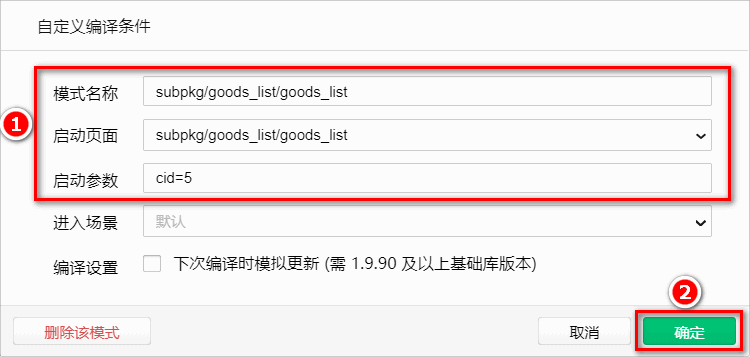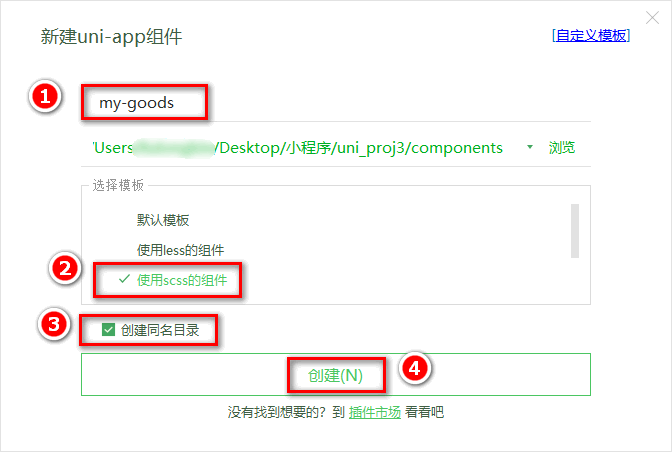

个人名片:
🐼作者简介:一名大二在校生,讨厌编程🎋
🐻❄️个人主页🥇:小新爱学习.
🐼个人WeChat:hmmwx53
🕊️系列专栏:🖼️
- 零基础学Java——小白入门必备
- 重识C语言——复习回顾
- 计算机网络体系———深度详讲
- 微信小程序开发——实战开发
- 基于黑马优选的小程序开发实战教程
🐓每日一句:🍭努力的意义是给所爱之人一个美好的未来!
文章目录
- 6. 商品列表
- 6.0 创建 goodslist 分支
- 6.1 定义请求参数对象
- 6.2 获取商品列表数据
- 6.3 渲染商品列表结构
- 6.4 把商品 `item` 项封装为自定义组件
- 6.5 使用过滤器处理价格
- 6.6 上拉加载更多
- 6.6.1 初步实现上拉加载更多
- 6.6.2 通过节流阀防止发起额外的请求
- 6.6.3 判断数据是否加载完毕
- 6.7 下拉刷新
- 6.8 点击商品 item 项跳转到详情页面
- 6.9 分支的合并与提交
6. 商品列表
6.0 创建 goodslist 分支
运行如下的命令,基于 master 分支在本地创建 goodslist 子分支,用来开发商品列表相关的功能:
git checkout -b search
- 1
6.1 定义请求参数对象
- 为了方便发起请求获取商品列表的数据,我们要根据接口的要求,事先定义一个请求参数对象:
data() {
return {
// 请求参数对象
queryObj: {
// 查询关键词
query: '',
// 商品分类Id
cid: '',
// 页码值
pagenum: 1,
// 每页显示多少条数据
pagesize: 10
}
}
}
- 1
- 2
- 3
- 4
- 5
- 6
- 7
- 8
- 9
- 10
- 11
- 12
- 13
- 14
- 15
- 将页面跳转时携带的参数,转存到
queryObj对象中:
onLoad(options) {
// 将页面参数转存到 this.queryObj 对象中
this.queryObj.query = options.query || ''
this.queryObj.cid = options.cid || ''
}
- 1
- 2
- 3
- 4
- 5
- 为了方便开发商品分类页面,建议大家通过
微信开发者工具,新建商品列表页面的编译模式:

6.2 获取商品列表数据
- 在
data中新增如下的数据节点:
data() {
return {
// 商品列表的数据
goodsList: [],
// 总数量,用来实现分页
total: 0
}
}
- 1
- 2
- 3
- 4
- 5
- 6
- 7
- 8
- 在
onLoad生命周期函数中,调用getGoodsList方法获取商品列表数据:
onLoad(options) {
// 调用获取商品列表数据的方法
this.getGoodsList()
}
- 1
- 2
- 3
- 4
- 在
methods节点中,声明getGoodsList方法如下:
methods: {
// 获取商品列表数据的方法
async getGoodsList() {
// 发起请求
const { data: res } = await uni.$http.get('/api/public/v1/goods/search', this.queryObj)
if (res.meta.status !== 200) return uni.$showMsg()
// 为数据赋值
this.goodsList = res.message.goods
this.total = res.message.total
}
}
- 1
- 2
- 3
- 4
- 5
- 6
- 7
- 8
- 9
- 10
- 11
6.3 渲染商品列表结构
- 在页面中,通过
v-for指令,循环渲染出商品的UI结构:
<template>
<view>
<view class="goods-list">
<block v-for="(goods, i) in goodsList" :key="i">
<view class="goods-item">
<!-- 商品左侧图片区域 -->
<view class="goods-item-left">
<image :src="goods.goods_small_logo || defaultPic" class="goods-pic"></image>
</view>
<!-- 商品右侧信息区域 -->
<view class="goods-item-right">
<!-- 商品标题 -->
<view class="goods-name">{{goods.goods_name}}</view>
<view class="goods-info-box">
<!-- 商品价格 -->
<view class="goods-price">¥{{goods.goods_price}}</view>
</view>
</view>
</view>
</block>
</view>
</view>
</template>
- 1
- 2
- 3
- 4
- 5
- 6
- 7
- 8
- 9
- 10
- 11
- 12
- 13
- 14
- 15
- 16
- 17
- 18
- 19
- 20
- 21
- 22
- 23
- 为了防止某些商品的图片不存在,需要在
data中定义一个默认的图片:
data() {
return {
// 默认的空图片
defaultPic: 'https://img3.doubanio.com/f/movie/8dd0c794499fe925ae2ae89ee30cd225750457b4/pics/movie/celebrity-default-medium.png'
}
}
- 1
- 2
- 3
- 4
- 5
- 6
- 并在页面渲染时按需使用:
<image :src="goods.goods_small_logo || defaultPic" class="goods-pic"></image>
- 1
- 美化商品列表的
UI结构:
.goods-item {
display: flex;
padding: 10px 5px;
border-bottom: 1px solid #f0f0f0;
.goods-item-left {
margin-right: 5px;
.goods-pic {
width: 100px;
height: 100px;
display: block;
}
}
.goods-item-right {
display: flex;
flex-direction: column;
justify-content: space-between;
.goods-name {
font-size: 13px;
}
.goods-price {
font-size: 16px;
color: #c00000;
}
}
}
- 1
- 2
- 3
- 4
- 5
- 6
- 7
- 8
- 9
- 10
- 11
- 12
- 13
- 14
- 15
- 16
- 17
- 18
- 19
- 20
- 21
- 22
- 23
- 24
- 25
- 26
- 27
- 28
- 29
- 30
6.4 把商品 item 项封装为自定义组件
- 在
components目录上鼠标右键,选择新建组件:

2. 将 goods_list 页面中,关于商品 item 项相关的 UI 结构、样式、data 数据,封装到 my-goods 组件中:
<template>
<view class="goods-item">
<!-- 商品左侧图片区域 -->
<view class="goods-item-left">
<image :src="goods.goods_small_logo || defaultPic" class="goods-pic"></image>
</view>
<!-- 商品右侧信息区域 -->
<view class="goods-item-right">
<!-- 商品标题 -->
<view class="goods-name">{{goods.goods_name}}</view>
<view class="goods-info-box">
<!-- 商品价格 -->
<view class="goods-price">¥{{goods.goods_price}}</view>
</view>
</view>
</view>
</template>
<script>
export default {
// 定义 props 属性,用来接收外界传递到当前组件的数据
props: {
// 商品的信息对象
goods: {
type: Object,
defaul: {},
},
},
data() {
return {
// 默认的空图片
defaultPic: 'https://img3.doubanio.com/f/movie/8dd0c794499fe925ae2ae89ee30cd225750457b4/pics/movie/celebrity-default-medium.png',
}
},
}
</script>
<style lang="scss">
.goods-item {
display: flex;
padding: 10px 5px;
border-bottom: 1px solid #f0f0f0;
.goods-item-left {
margin-right: 5px;
.goods-pic {
width: 100px;
height: 100px;
display: block;
}
}
.goods-item-right {
display: flex;
flex-direction: column;
justify-content: space-between;
.goods-name {
font-size: 13px;
}
.goods-price {
font-size: 16px;
color: #c00000;
}
}
}
</style>
- 1
- 2
- 3
- 4
- 5
- 6
- 7
- 8
- 9
- 10
- 11
- 12
- 13
- 14
- 15
- 16
- 17
- 18
- 19
- 20
- 21
- 22
- 23
- 24
- 25
- 26
- 27
- 28
- 29
- 30
- 31
- 32
- 33
- 34
- 35
- 36
- 37
- 38
- 39
- 40
- 41
- 42
- 43
- 44
- 45
- 46
- 47
- 48
- 49
- 50
- 51
- 52
- 53
- 54
- 55
- 56
- 57
- 58
- 59
- 60
- 61
- 62
- 63
- 64
- 65
- 66
- 67
- 68
- 69
- 在
goods_list组件中,循环渲染my-goods组件即可:
<view class="goods-list">
<block v-for="(item, i) in goodsList" :key="i">
<!-- 为 my-goods 组件动态绑定 goods 属性的值 -->
<my-goods :goods="item"></my-goods>
</block>
</view>
- 1
- 2
- 3
- 4
- 5
- 6
6.5 使用过滤器处理价格
- 在
my-goods组件中,和data节点平级,声明filters过滤器节点如下:
filters: {
// 把数字处理为带两位小数点的数字
tofixed(num) {
return Number(num).toFixed(2)
}
}
- 1
- 2
- 3
- 4
- 5
- 6
- 在渲染商品价格的时候,通过管道符
|调用过滤器:
<!-- 商品价格 -->
<view class="goods-price">¥{{goods.goods_price | tofixed}}</view>
- 1
- 2
6.6 上拉加载更多
6.6.1 初步实现上拉加载更多
- 打开项目根目录中的
pages.json配置文件,为subPackages分包中的goods_list页面配置上拉触底的距离:
"subPackages": [
{
"root": "subpkg",
"pages": [
{
"path": "goods_detail/goods_detail",
"style": {}
},
{
"path": "goods_list/goods_list",
"style": {
"onReachBottomDistance": 150
}
},
{
"path": "search/search",
"style": {}
}
]
}
]
- 1
- 2
- 3
- 4
- 5
- 6
- 7
- 8
- 9
- 10
- 11
- 12
- 13
- 14
- 15
- 16
- 17
- 18
- 19
- 20
- 21
- 在
goods_list页面中,和methods节点平级,声明onReachBottom事件处理函数,用来监听页面的上拉触底行为:
// 触底的事件
onReachBottom() {
// 让页码值自增 +1
this.queryObj.pagenum += 1
// 重新获取列表数据
this.getGoodsList()
}
- 1
- 2
- 3
- 4
- 5
- 6
- 7
- 改造
methods中的getGoodsList函数,当列表数据请求成功之后,进行新旧数据的拼接处理:
// 获取商品列表数据的方法
async getGoodsList() {
// 发起请求
const { data: res } = await uni.$http.get('/api/public/v1/goods/search', this.queryObj)
if (res.meta.status !== 200) return uni.$showMsg()
// 为数据赋值:通过展开运算符的形式,进行新旧数据的拼接
this.goodsList = [...this.goodsList, ...res.message.goods]
this.total = res.message.total
}
- 1
- 2
- 3
- 4
- 5
- 6
- 7
- 8
- 9
- 10
6.6.2 通过节流阀防止发起额外的请求
- 在
data中定义isloading节流阀如下:
data() {
return {
// 是否正在请求数据
isloading: false
}
}
- 1
- 2
- 3
- 4
- 5
- 6
- 修改
getGoodsList方法,在请求数据前后,分别打开和关闭节流阀:
// 获取商品列表数据的方法
async getGoodsList() {
// ** 打开节流阀
this.isloading = true
// 发起请求
const { data: res } = await uni.$http.get('/api/public/v1/goods/search', this.queryObj)
// ** 关闭节流阀
this.isloading = false
// 省略其它代码...
}
- 1
- 2
- 3
- 4
- 5
- 6
- 7
- 8
- 9
- 10
- 11
- 在
onReachBottom触底事件处理函数中,根据节流阀的状态,来决定是否发起请求:
// 触底的事件
onReachBottom() {
// 判断是否正在请求其它数据,如果是,则不发起额外的请求
if (this.isloading) return
this.queryObj.pagenum += 1
this.getGoodsList()
}
- 1
- 2
- 3
- 4
- 5
- 6
- 7
- 8
6.6.3 判断数据是否加载完毕
- 如果下面的公式成立,则证明没有下一页数据了:
当前的页码值 * 每页显示多少条数据 >= 总数条数
pagenum * pagesize >= total
- 1
- 2
- 修改
onReachBottom事件处理函数如下:
// 触底的事件
onReachBottom() {
// 判断是否还有下一页数据
if (this.queryObj.pagenum * this.queryObj.pagesize >= this.total) return uni.$showMsg('数据加载完毕!')
// 判断是否正在请求其它数据,如果是,则不发起额外的请求
if (this.isloading) return
this.queryObj.pagenum += 1
this.getGoodsList()
}
- 1
- 2
- 3
- 4
- 5
- 6
- 7
- 8
- 9
- 10
- 11
6.7 下拉刷新
- 在
pages.json配置文件中,为当前的goods_list页面单独开启下拉刷新效果:
"subPackages": [{
"root": "subpkg",
"pages": [{
"path": "goods_detail/goods_detail",
"style": {}
}, {
"path": "goods_list/goods_list",
"style": {
"onReachBottomDistance": 150,
"enablePullDownRefresh": true,
"backgroundColor": "#F8F8F8"
}
}, {
"path": "search/search",
"style": {}
}]
}]
- 1
- 2
- 3
- 4
- 5
- 6
- 7
- 8
- 9
- 10
- 11
- 12
- 13
- 14
- 15
- 16
- 17
- 监听页面的
onPullDownRefresh事件处理函数:
// 下拉刷新的事件
onPullDownRefresh() {
// 1. 重置关键数据
this.queryObj.pagenum = 1
this.total = 0
this.isloading = false
this.goodsList = []
// 2. 重新发起请求
this.getGoodsList(() => uni.stopPullDownRefresh())
}
- 1
- 2
- 3
- 4
- 5
- 6
- 7
- 8
- 9
- 10
- 11
- 修改
getGoodsList函数,接收cb回调函数并按需进行调用:
// 获取商品列表数据的方法
async getGoodsList(cb) {
this.isloading = true
const { data: res } = await uni.$http.get('/api/public/v1/goods/search', this.queryObj)
this.isloading = false
// 只要数据请求完毕,就立即按需调用 cb 回调函数
cb && cb()
if (res.meta.status !== 200) return uni.$showMsg()
this.goodsList = [...this.goodsList, ...res.message.goods]
this.total = res.message.total
}
- 1
- 2
- 3
- 4
- 5
- 6
- 7
- 8
- 9
- 10
- 11
- 12
6.8 点击商品 item 项跳转到详情页面
- 将循环时的
block组件修改为view组件,并绑定click点击事件处理函数:
<view class="goods-list">
<view v-for="(item, i) in goodsList" :key="i" @click="gotoDetail(item)">
<!-- 为 my-goods 组件动态绑定 goods 属性的值 -->
<my-goods :goods="item"></my-goods>
</view>
</view>
- 1
- 2
- 3
- 4
- 5
- 6
- 在
methods节点中,定义gotoDetail事件处理函数:
// 点击跳转到商品详情页面
gotoDetail(item) {
uni.navigateTo({
url: '/subpkg/goods_detail/goods_detail?goods_id=' + item.goods_id
})
}
- 1
- 2
- 3
- 4
- 5
- 6
6.9 分支的合并与提交
- 将
goodslist分支进行本地提交:
git add .
git commit -m "完成了商品列表页面的开发"
- 1
- 2
- 将本地的
goodslist分支推送到码云:
git push -u origin goodslist
- 1
- 将本地
goodslist分支中的代码合并到 master 分支:
git checkout master
git merge goodslist
git push
- 1
- 2
- 3
- 删除本地的
goodslist分支:
git branch -d goodslist
- 1

文章知识点与官方知识档案匹配,可进一步学习相关知识
小程序技能树page.json配置globalStyle全局样式配置4990 人正在系统学习中



